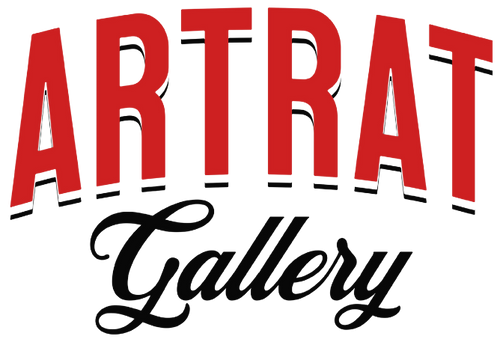
On Thursday, April 20, ArtRat Gallery will hold an opening reception for “New Beginnings,” its spring show featuring painters Justin Shull and Colleen Gleason Shull.
The exhibit runs through July 20 and features “recent paintings in conversation” as the former artist couple explores new chapters in their individual artistic journeys. Justin and Colleen have collaborated on past projects, and their individual work has responded to and evolved in relation to each other over the past 20 years.

Ahead of the Third Thursday opening, ArtRat asked the artists about their creative process and latest work, and the influences that shaped their aesthetics. Here’s what Justin Shull had to say about “New Beginnings.”
Your recent works are larger scale, and you quote from media and traditions like collage and Persian miniatures. Did the bigger canvases inspire the new themes, or vice versa, or are they a convergence?
These new large paintings are a convergence of historical and contemporary references at a scale that engages the whole body in person.
I have wanted to paint larger for a while: I want paintings that can simultaneously read as a whole image on a handheld smartphone screen, and also offer a somatic experience when viewed full-size in person. Larger canvases that span the viewer’s field of view become an immersive experience, and I’m interested in utilizing this phenomenon in relation to the themes I’m exploring in the paintings: the collapsing of boundaries between our physical and digital realties, our daily exposure to a stream of unrelated images that span historical periods and styles, and the lines we draw between documentation and invention.

Your environment seems to play a key role in your work: You're known for your bright landscapes, often painted en plein air. How has your current base in the Traverse City area influenced this work compared to, say, earlier tenures in Los Angeles or New Jersey?
I paint what I experience. Every painting has to come from a very personal experience for me, and hopefully those experiences will resonate with an audience. I decided several years ago that I wanted to support myself with my art. Since then, my focus has been finding a balance between making paintings that are personally meaningful while also appealing to collectors, and I’m still figuring out what the right subject and content and style combinations are for me as a painter.
I have always been fascinated with the landscape as a painting subject: The landscape embodies our relationship with the natural world (cultural assumptions, beliefs, interactions), and it’s also often a celebratory subject. So the landscapes I experience inform many of my paintings, and sometimes those paintings are more intellectually challenging, and sometimes they are more celebratory. The new larger paintings ostensibly veer away from “outdoor landscapes,” but they still share an interest in our built environment, the ways in which we construct reality, and the joys and challenges of being human.

Who do you consider major influences in your artistic development, and how did they help shape your perception/execution?
A history-spanning shortlist of artists who had formative influence on me include: Peter Paul Rubens, Anselm Kiefer, Käthe Kollwitz, Chuck Close, Claude Monet, Utagawa Hiroshige, and Stanley Lewis (whom I studied with in undergrad).
I learned different lessons from each of these artists: the power of monumental scale, the profound impact of various color combinations, the ways that materiality can be pushed to extremes in image making, how the natural world can be simplified and stylized in ways that still convey something essential and believable, how the canvas is a stage for action and how that action is always in relation to the subject presented.
What contemporary artists excite you, and why?
In addition to the artists mentioned above, I have a deep appreciation for David Hockney: his use of color and scale, his playfulness and irreverence, and how these inform his explorations in landscape painting. Another standout for me is Martha Rosler (who I studied with in grad school). Her photo collages pull from pop culture publications and advertisements, dealing with topics of war, identity and social justice in ways that I have found pertinent and inspiring.

In addition to art, you've been involved in the design of video games. Have the two disciplines contributed to an overall aesthetic, or are they very distinct in your mind?
I really love the range of visual styles in video games. The artists making the characters and environments in video games pull inspiration from an incredible range of art historical references and as a result, it’s a fascinating space where a lot of invention and remixing happens. I am only recently beginning to incorporate some of that range and playfulness into my own art.
You've lived in many places during your career. Do you think regional art scenes are still significant in this interconnected digital era?
I think it’s nearly impossible to paint in a regional vacuum these days. I do think that the cultural and geographic specifics of a region can still inform one’s practice, and can manifest in the work: celebrating a place and its history, for example, often results in paintings with regional subject matter. But I also think that our level of interconnectedness is such that it’s difficult for any regional art scene not to be aware of and connected to a global community.


